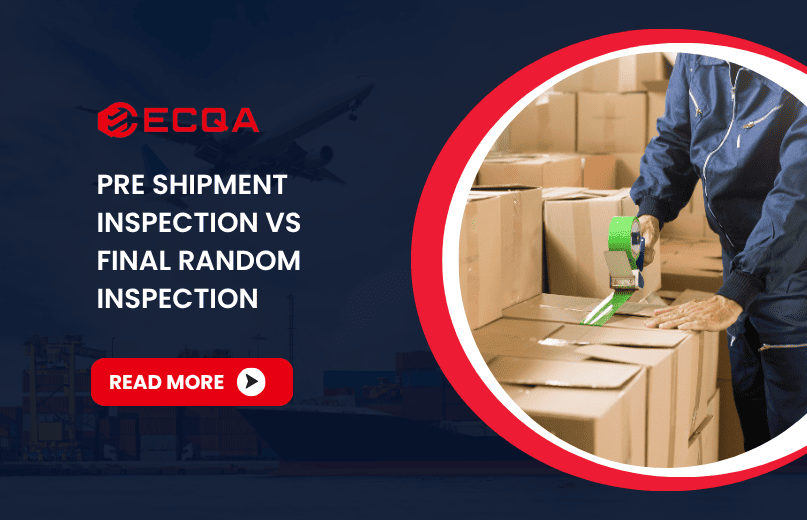
Pre-Shipment Inspection vs Final Random Inspection
Pre-Shipment Inspection (PSI) and Final Random Inspection (FRI ) are two essential quality control procedures used to verify product conformity before goods leave the factory. Both play a critical role in preventing costly mistakes, ensuring compliance with buyer specifications, and maintaining brand reputation.

While they appear similar in timing, their purpose and methodology differ significantly. Pre-Shipment Inspection focuses on verifying the general quality and readiness of goods before shipment, whereas Final Random Inspection provides a statistical assessment of a shipment’s quality through random sampling. Selecting the right inspection type depends on production progress, risk level, and customer requirements.
Understanding Pre-Shipment Inspection
A Pre-Shipment Inspection is conducted when production is nearly complete, typically at 80–100 percent finished goods and before final packing. It is designed to catch quality issues before the products are shipped out.
Objectives of Pre-Shipment Inspection
The main goal of Pre-Shipment Inspection is to confirm that the goods produced meet contractual specifications. Inspectors assess the product’s appearance, functionality, and packaging quality to ensure that they comply with buyer expectations.
Key objectives include:
- Verifying product conformity against approved samples or technical files
- Checking workmanship for visible or functional defects
- Confirming labeling, packaging, and marking accuracy
- Testing product performance when applicable
- Ensuring quantities produced and packed match the purchase order
When to Conduct Pre-Shipment Inspection
Pre-Shipment Inspection is most useful when the buyer wants to ensure quality before the goods leave the supplier’s premises. For example, if the products are going directly to retail or a tight distribution schedule, Pre-Shipment Inspection ensures that only acceptable goods proceed to final shipment.
Typical Pre-Shipment Inspection Procedures
Inspectors usually follow internationally recognized protocols such as:
- Sampling Plan – Based on ANSI/ASQ Z1.4 or ISO 2859-1 standards.
- Visual Inspection – Checking external defects, color consistency, labeling, and finishing.
- Functional Testing – Performing relevant safety or performance checks.
- Measurement Verification – Confirming dimensions and tolerances.
- Packing and Marking Review – Ensuring barcodes, labels, and packaging match buyer requirements.
Benefits of Pre-Shipment Inspection
- Prevents defective goods from leaving the factory
- Allows time for rework before shipment
- Strengthens supplier accountability
- Reduces disputes between buyers and manufacturers
- Protects logistics costs by minimizing returns or recalls
Understanding Final Random Inspection (FRI)
A Final Random Inspection is performed after 100 percent of production is complete and at least 80 percent of goods are packed for shipment. Unlike Pre-Shipment Inspection, this inspection follows a strict statistical sampling method to represent the overall lot quality.
Objectives of Final Random Inspection
The purpose of Final Random Inspection is to provide a data-driven assessment of the shipment. It determines whether the batch meets the Acceptable Quality Limit (AQL) defined by the buyer.
Main objectives include:
- Evaluating overall product quality through random sample selection
- Identifying defect levels (critical, major, and minor)
- Confirming compliance with AQL acceptance criteria
- Checking carton sealing, labeling, and export readiness
- Validating documentation such as packing lists and product markings
Sampling Method in Final Random Inspection
Final Random Inspection uses AQL sampling, a method that balances inspection effort and statistical reliability. The inspector randomly selects samples based on the batch size.
For example:
- A batch of 5,000 units may require 200 sampled items.
- The sample is inspected, and defects are categorized.
- The results determine whether the shipment passes or fails according to the AQL threshold.
Benefits of Final Random Inspection
- Provides objective, data-based quality verification
- Confirms whether shipment meets the agreed defect tolerance
- Reduces risk of large-scale non-conformities
- Offers documented assurance for customs, buyers, and regulators
- Enhances confidence in supplier performance over time
For a detailed guide on AQL sampling tables, inspection levels, and defect classification, you can download our free AQL Inspection eBook here
Core Differences Between Pre-Shipment and Final Random Inspection
| Pre-Shipment Inspection (PSI) | Final Random Inspection (FRI) | |
| Timing | Conducted when 80–100% of production is completed | Conducted after 100% production and 80% packing |
| Sampling Method | Targeted checks based on buyer requirements | Statistical random sampling under AQL |
| Purpose | Identify visible or functional defects early | Quantitatively assess shipment quality |
| Inspection Focus | Workmanship, labeling, packaging, and readiness | Defect rate evaluation and shipment approval |
| Corrective Actions | Allows time for rework before shipment | Limited opportunity for correction |
| Decision Outcome | Advisory for corrective measures | Pass or fail decision based on AQL |
In short, Pre-Shipment Inspection provides qualitative assurance, while Final Random Inspection delivers quantitative validation. The two approaches complement each other when applied strategically.
Choosing Between Pre-Shipment Inspection and Final Random Inspection
Selecting between Pre-Shipment and Final Random Inspection depends on product type, risk level, and operational timelines.
When Pre-Shipment Inspection Is More Suitable
- Production involves complex designs or customized features.
- You want early visibility into potential issues.
- Shipment deadlines allow time for adjustments.
- Supplier reliability is unproven or inconsistent.
Example: For a new electronics supplier producing customized power adapters, Pre-Shipment Inspection allows the buyer to confirm safety labeling and cable length before the goods are sealed.
When Final Random Inspection is more Suitable
- You require statistical proof of quality performance.
- The order involves standardized, high-volume goods.
- You need to issue an official acceptance or rejection report.
- The buyer–supplier agreement specifies AQL compliance.
Example: For a large textile order of 20,000 garments, Final Random Inspection ensures defect rates remain within the AQL limit before release.
When to Combine Both
Many importers adopt dual inspection, a Pre-Shipment Inspection at 80 percent completion to correct early issues and an Final Random Inspection before shipment for statistical confirmation. This combined model minimizes risk across both production and shipment stages.
Inspection Standards and Methodologies
Both Pre-Shipment Inspection and Final Random Inspection rely on international frameworks to maintain consistency and credibility.
a. ANSI/ASQ Z1.4 (ISO 2859-1)
Defines the statistical sampling methods used for AQL inspections. It helps determine sample size, inspection level, and acceptance or rejection numbers.
b. ISO/IEC 17020
Specifies general criteria for bodies performing inspection activities, ensuring independence, competence, and impartiality.
c. ISO/IEC 17025
Applies when testing or calibration is required as part of the inspection process, ensuring the accuracy and traceability of test results.
d. Internal Quality Protocols
Many third-party inspection develop proprietary checklists tailored to product categories such as electronics, textiles, toys, or furniture. These checklists ensure that inspections cover both regulatory and buyer-specific requirements.
Effective inspection planning determines whether a shipment strengthens or damages your brand’s reputation. Pre-Shipment Inspection provides early quality assurance and corrective flexibility, while Final Random Inspection delivers objective statistical validation.
For inspection cost references, you can also read: How Much Does an Inspection Cost?
If a report indicates non-conformity, see: How to Handle a Failed Product Inspection.

 Request Free Sample Report
Request Free Sample Report